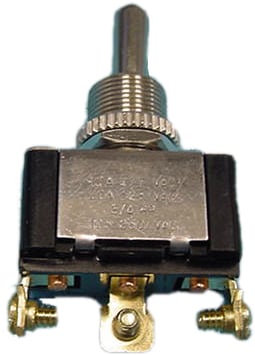Sign up now to join the JEGS email newsletter and be the first to learn about new products, special deals and e-mail only offers!


When working on an electrical project for your car or truck, one of the most common components is a switch. Switches allow you to control whether parts are turned on or off. They also can be designed to control more than one component or function. There are different styles of switches available with the "toggle" design being the most popular. To help you better understand toggle switches, we have have gathered and answered the below most commonly asked questions about wiring.
Depending on the switch type, the number of connections, and the application, the directions on how to hook up a toggle switch will change. In its most basic form, a toggle switch contains two terminals. One side connects to power from the battery or appropriate fuse box circuit ("Bat"). The other side goes to the accessory you would like to turn on when the toggle switch is activated ("Load"). When the switch is turned on, a connection is made between the "bat" side and "load" side, allowing power to flow from the switch to the part, activating it. In certain cases, a fuse is required to protect the circuit from too many amps. In other cases a relay is used to provide the correct amount of power directly to the part.

There are two main types of 3-prong toggle switches. The first is a lighted LED toggle switch. This type of switch connects with a ground, an input (from battery power), and an output ("load", to the part needing electricity). The ground is needed to complete the circuit for the lamp in order for it to illuminate. The other type of three-prong switch is an "on-off-on" switch. this switch has an input from battery power ("bat") to the center connector and output ("load") to the other two connectors, depending on the switch position. The switch is designed to apply power to one circuit when flipped one direction, another circuit when flipped in the opposite direction, and neither circuit when left in the middle. When one circuit is flipped on, the other circuit is off.


Sign up now to join the JEGS email newsletter and be the first to learn about new products, special deals and e-mail only offers!



There are two main types of "on/off/on" toggle switches. The first is referred to as a "single pole/double throw" switch. The center connector is input from the battery. The outer connectors go to separate circuits. This allows you to power one circuit if switched to one side, the other circuit when switched to the opposite side, and neither circuit when positioned in the middle. The other type of on/off/on switch is called a "double pole/double throw" switch. It contains six connections. The middle two connect to one or two different batteries. The outer pairs of connectors attach to four different circuits. When connected, switching to one side will connect one battery connection to two different circuits. Switching to the opposite position will connect the other battery connection to two other circuits. If left in the middle position, the toggle doesn't power any circuits.
Wiring headlights to a toggle switch requires the use of two relays. The toggle switch triggers the relays to provide power to the low or high beams on the headlights. The relays are wired with four of the five available connectors. One connector is run to the battery. Another connector is grounded. The third connector goes to an on-off-on toggle switch, with high-beam relay to one side and low-beam relay to the other (the other connection on the toggle switch is battery power to provide the signal to either relay. The last connector goes to the headlight(s). This allows the toggle switch to control either the low or high beams. A fuse may need to be added, depending on the application.




